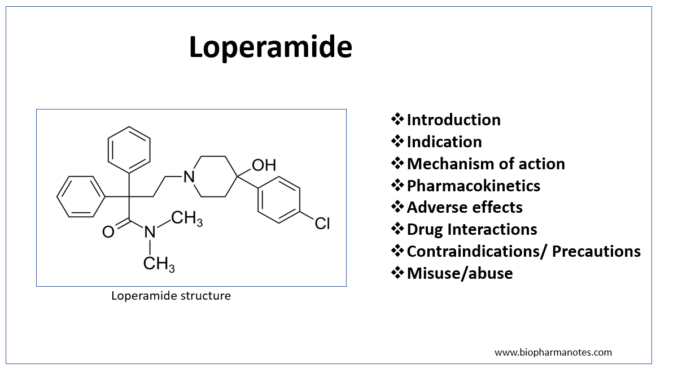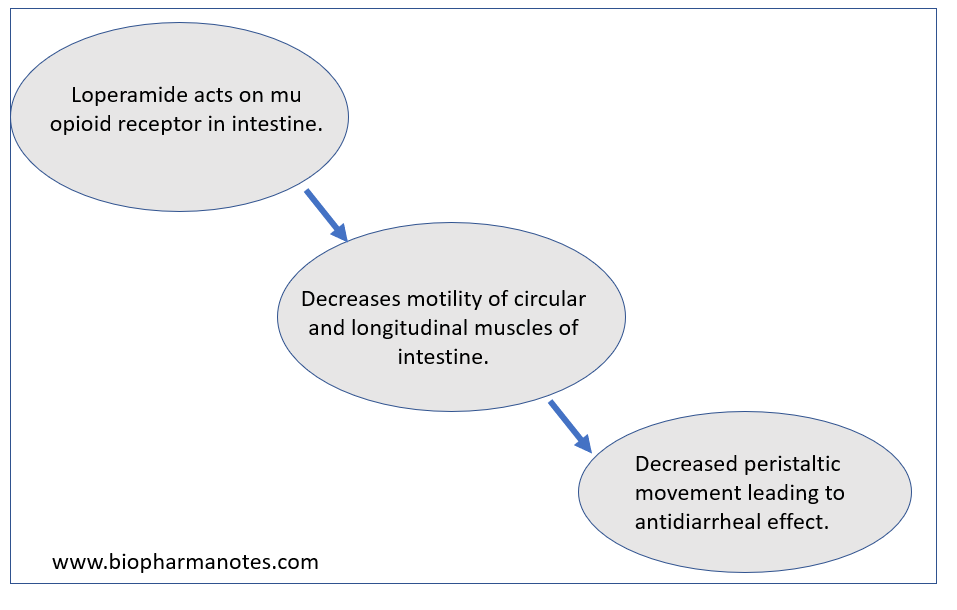
- Loperamide is popular antidiarrheal medicine used from many years in medical field. It was synthesized in 1969 and got its FDA approval and first used medically in 1976. It became available without prescription in 1988.
- Loperamide is included in World Health Organization’s (WHO) List of Essential Medicines and is also available as generic medicine. Its structure resembles with that of pethidine. Chemically, it is piperidine butyramide derivative
Indications of loperamide
- Used to treat various types of diarrhea symptoms including traveler’s diarrhea, acute non- specific diarrhea, AIDS (Acquired Immunodeficiency Syndrome) associated diarrhea and chronic diarrhea associated with IBD (Inflammatory Bowel Disease).
- Used for reducing ileostomy output.
- Off-label use include treating chemotherapy associated diarrhea.
Mechanism of action of loperamide

Figure- Mechanism of action of Loperamide
- It is an opioid receptor agonist which acts directly on intestinal mu opioid receptors particularly present in myenteric plexus large intestines and decreases motility of circular and longitudinal muscles of the intestinal wall. This inhibition of peristaltic movement increases small intestinal and mouth-to-cecum transit time.
- It is a non-selective calcium channel blocker and also directly binds to calmodulin at high concentration which is responsible for antidiarrheal action.
- It also shows antisecretory activity. The antisecretory activity is against cholera toxins and some form of Escherichia Coli toxins. It also increases anal sphincter tone which helps to improve fecal continence.
Pharmacokinetics of loperamide
- Loperamide is orally administered drug and is available as tablets, capsules, solution and chewable form. It takes 3-5 hours to reach peak plasma level after oral administration. It is not well absorbed after oral administration and systemic bioavailability is about 0.3%.
- Half-life is around 11 hours. It’s duration of action is longer than of codeine and diphenoxylate. It undergoes extensive metabolism in liver. It is metabolized by CYP2C8 and CYP3A4 to desmethylloperamide. Excretion takes place via bile. It has high protein binding and shows large volume of distribution.
- At usual dose, it lacks analgesic activity. It is much more potent than morphine and codeine as antidiarrheal agent. CNS penetration is poor and rare in usual doses and occurs only in high doses. As it doesn’t cross CNS, CNS toxicity is rare.
Adverse Effects
- As it is administered for short term for any kind of indication, its most of the side effects are self-limiting. Most common side effects are abdominal cramps and rashes. It can also cause flatulence, urinary retention, dizziness and drowsiness.
- Some serious side effects include Steven- Johnson syndrome, syncope, ventricular tachycardia and necrotizing enterocolitis. It can cause toxic megacolon if used in young children or in patients with severe colitis.
- Large doses can cause systemic effects similar to opioid toxicity which includes respiratory depression, CNS depression and also cardiac conduction abnormalities.
Drug Interactions
- Its concurrent administration with drugs that decrease intestinal motility or cause constipation like antimuscarinics, opioids can cause severe constipation.
- Cholestyramine may bind with loperamide in GI tract and decrease its ability to work. Ritonavir increases peak plasma concentration of loperamide by 17% and decrease its clearance by about 70%.
Contraindications/Precautions
- Contraindicated in patients with known hypersensitivity reaction to loperamide.
- Not recommended to use in children below 2 years age.
- It should not be used in patients with severe colitis.
- Should not be used without medical supervision in patients with bloody diarrhea and diarrhea associated with bacterial infections.
Loperamide misuse
- Due to its easy availability and non- expensiveness, there is an increase in its non-illicit use. It has become popular among opioid users. It is used in high doses (40-100 times) than the recommended antidiarrheal dose to get euphoric effect.
- In a study performed, it was found that intentional non-medical use of loperamide had increase by 91% between 2010 and 2015.
- It is also used to self- medicate withdrawal symptoms associated with opioid withdrawal syndrome. People may use it as a way to treat physical dependence on opioids rather than to simulate euphoric effects of opioids. However, for this its should be used in high doses which can lead to overdose.
References
- Baker DE. Loperamide: A Pharmacological Review. Rev Gastroenterol Disord. 2007; 7(suppl 3): S11-S18.
- Heel RC et al. Loperamide: a review of its pharmacological properties and therapeutic efficacy in diarrhea. Drugs. 1978 Jan;15(1):33-52.
- Akel T. Bekheit S. Loperamide cardiotoxicity: “A Brief Review”. Ann Noninvasive Electrocardiol. 2018; 23(2): e12505.
- https://go.drugbank.com/drugs/DB00836
- https://www.statpearls.com/ArticleLibrary/viewarticle/24418
- https://www.therecoveryvillage.com/imodium-addiction/
- Essentials of Medical Pharmacology. 7th edition.
- Lippincott Illustrated Reviews Pharmacology, 6th edition.
- Pharmacology and pharmacotherapeutics. 24th edition.
- Goodman and Gillman Manual of Pharmacology and Therapeutics.